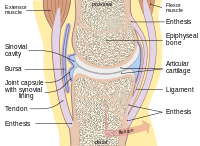
Photo from wikipedia
PURPOSE Lubricin, a boundary lubricant, is the body's unique antiadhesive, antifibrotic, antifriction, and antiinflammatory glycoprotein. This amphiphile is produced by numerous tissues and acts to regulate a number of processes,… Click to show full abstract
PURPOSE Lubricin, a boundary lubricant, is the body's unique antiadhesive, antifibrotic, antifriction, and antiinflammatory glycoprotein. This amphiphile is produced by numerous tissues and acts to regulate a number of processes, such as homeostasis, shear stress, tissue development, innate immunity, inflammation, and wound healing. We hypothesize that lubricin is also synthesized and expressed by the amniotic membrane (AM), which also possesses antiadhesive, antifibrotic, and antiinflammatory properties. We also hypothesize that lubricin, at least in part, mediates these AM capabilities. Our goal was to test our hypothesis. METHODS We obtained multiple samples of fresh, cryopreserved (CP), and freeze-dried (FD) human AMs, as well as fresh placental tissue as positive controls, and processed them for light microscopy, immunofluorescence, and western blot analyses. We also evaluated the ability of recombinant human lubricin to associate with FD-AMs. RESULTS Our results demonstrate that all fresh placental, fresh AM, and CP-AM samples contained lubricin. Lubricin was expressed in placental chorionic villi, AM epithelial and stromal cells, and CP-AM epithelia. No lubricin could be detected in FD-AMs but could be restored in FD-AMs after overnight incubation with recombinant human lubricin. CONCLUSIONS This study supports our hypothesis that lubricin is expressed in human AMs. In addition, our data show that preservation methods influence the extent of this expression. Indeed, the disappearance of lubricin in FD-AMs may explain why dried AM reportedly loses its antiinflammatory and antiscarring abilities. It is possible that lubricin may mediate, at least in part, many of the biological properties of AMs.
Journal Title: Cornea
Year Published: 2019
Link to full text (if available)
Share on Social Media: Sign Up to like & get
recommendations!